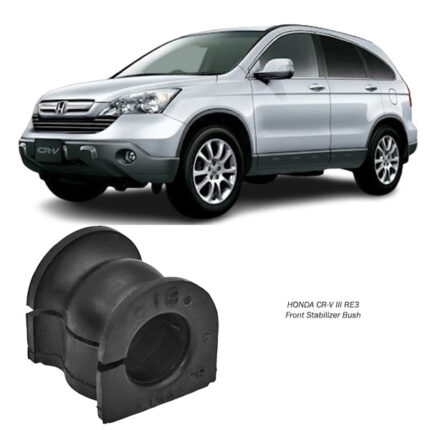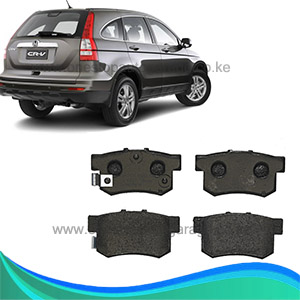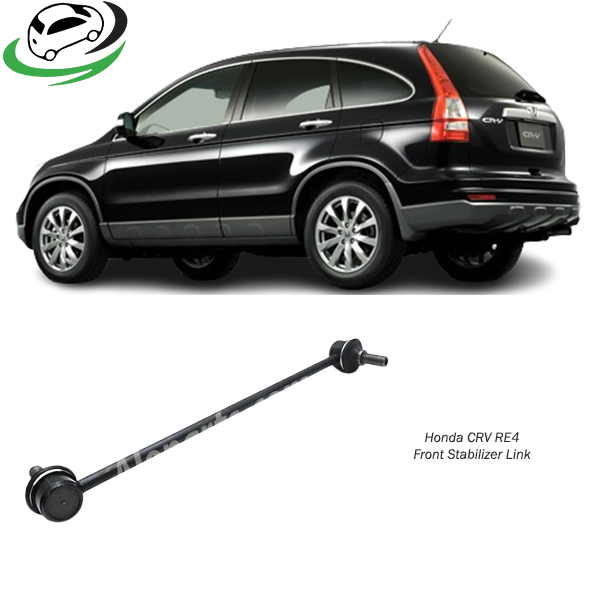-9%
Get Honda CRV RE4 Front Stabilizer Link SLH020 in Kenya
The front stabilizer link, also known as the sway bar link or anti-roll bar link, is a small but crucial component within the suspension system of a vehicle. Its primary function is to connect the sway bar (or stabilizer bar) to the suspension, reducing body roll and enhancing stability, particularly during turns or when driving on uneven surfaces. Despite its relatively simple design, the stabilizer link significantly impacts vehicle handling, safety, and ride comfort. In this article, we’ll explore the construction, functionality, benefits, common issues, and maintenance of the front stabilizer link.
1. Understanding the Structure of the Front Stabilizer Link
The front stabilizer link typically consists of a straightforward design with a few key components:
- Link Rod: The central part of the stabilizer link is a sturdy rod, usually made of steel or aluminum, which can withstand the forces exerted by the suspension. Some modern stabilizer links are made from lightweight materials to reduce overall vehicle weight.
- Ball Joints or Bushings: On either end of the stabilizer link, there are either ball joints or rubber/polyurethane bushings. Ball joints allow rotational flexibility and help the link adapt to changes in the suspension angle, while bushings provide a cushion that absorbs vibrations and shocks.
- Protective Coatings or Boots: Many stabilizer links feature protective rubber boots or coatings around the ball joints to guard against moisture, dirt, and debris, prolonging the part’s lifespan.
The link is connected to the sway bar and suspension via bolts and fasteners, and its precise installation is essential to ensure it operates as intended. This configuration enables the stabilizer link to transmit the sway bar’s forces across the suspension system, minimizing excessive body movement.
2. Functionality of the Front Stabilizer Link
The primary function of the front stabilizer link is to connect the sway bar to the vehicle’s suspension system, providing stability and balance during various driving conditions. Here’s how it works in greater detail:
a. Reducing Body Roll
When a vehicle turns, centrifugal force shifts its weight to the outer wheels, causing body roll or leaning. The sway bar counteracts this force by distributing it across the suspension. The stabilizer link plays a vital role in this process by connecting the sway bar to the suspension and helping apply an equal and opposite force on the inner wheels. This action minimizes body roll, allowing the vehicle to maintain a level position even during sharp turns.
b. Improving Handling and Steering Responsiveness
The stabilizer link directly impacts how the sway bar interacts with the suspension, which in turn affects handling and steering response. By helping the sway bar control lateral movement, the stabilizer link ensures that the vehicle remains stable, especially during sudden steering maneuvers or when taking corners. This stabilizing effect provides the driver with more control, enhancing overall safety.
c. Enhancing Ride Comfort
In addition to improving handling, the stabilizer link contributes to a smoother ride. By reducing excessive side-to-side motion, it helps prevent sudden shifts and swaying, allowing the vehicle to travel more comfortably on uneven or bumpy roads.
3. Benefits of the Front Stabilizer Link
The stabilizer link may be a small part, but it provides numerous benefits that improve both safety and ride quality:
a. Increased Vehicle Stability
The stabilizer link’s main function of reducing body roll leads to greater vehicle stability, especially during turns. This stability makes it easier for drivers to maintain control, which is particularly important when navigating sharp curves or avoiding obstacles.
b. Enhanced Tire Contact with the Road
By minimizing lateral motion, the stabilizer link helps keep all four tires in contact with the road surface. This maximized contact improves traction, which is essential for maintaining vehicle control, particularly in wet or slippery conditions.
c. Improved Suspension Longevity
Since the stabilizer link helps distribute forces across the suspension, it prevents certain parts from being overstressed, reducing wear and tear. This balanced distribution can help extend the life of other suspension components like the control arms and bushings.
d. Reduced Wear on Tires
The stabilizer link’s stabilizing effect on the suspension reduces uneven tire wear caused by excessive body roll. Even tire wear leads to a longer lifespan for the tires and more consistent handling over time.
4. Common Issues and Signs of a Failing Stabilizer Link
Although the stabilizer link is designed to be durable, it can wear out due to exposure to harsh road conditions, corrosion, and the stresses it endures. Here are some common signs of a failing stabilizer link:
a. Clunking or Rattling Noises
One of the most common symptoms of a worn or broken stabilizer link is a clunking or rattling noise coming from the front suspension, especially when driving over bumps or making turns. This noise is usually caused by loose or damaged bushings or ball joints within the link.
b. Poor Handling and Increased Body Roll
A worn stabilizer link can reduce the sway bar’s effectiveness, leading to increased body roll. Drivers may feel as if the vehicle is less stable during turns or feels “loose” on uneven roads.
c. Uneven or Rapid Tire Wear
A malfunctioning stabilizer link can contribute to uneven tire wear, as it fails to properly stabilize the vehicle. Uneven tire wear is often an indicator that the suspension system is not operating as it should.
d. Visual Wear and Damage
Upon inspection, a worn stabilizer link may show visible signs of damage, such as cracked or worn-out bushings, rust, or corrosion on the link rod, and damage to the rubber boots covering the ball joints.
5. Maintenance and Replacement of the Front Stabilizer Link
Proper maintenance and timely replacement of the stabilizer link can prevent larger suspension issues and improve vehicle stability. Here are some maintenance and replacement tips:
a. Routine Inspections
It’s essential to inspect the stabilizer link regularly, especially during routine suspension or brake checks. Look for any signs of wear on the bushings, ball joints, and link rod. Worn bushings or loose ball joints should be replaced promptly.
b. Replace When Necessary
If the stabilizer link shows signs of wear, such as clunking noises, reduced handling, or visual damage, it’s best to replace it. Waiting too long can lead to further damage to the suspension system.
c. Use High-Quality Parts
When replacing the stabilizer link, it’s crucial to use high-quality parts that meet OEM standards. High-quality stabilizer links typically last longer and perform better, providing lasting stability and reducing the need for frequent replacements.
d. Consider Replacing Links in Pairs
Even if only one stabilizer link is worn, it’s often advisable to replace both front stabilizer links at the same time. Replacing them in pairs ensures balanced handling, as a new link on one side can create an imbalance if the link on the other side is worn.
e. Professional Installation Recommended
While replacing stabilizer links isn’t a complicated job, proper installation is crucial for optimal performance. A professional technician can ensure that the new links are correctly torqued and aligned, preventing premature wear and ensuring effective stabilization.
Conclusion
The front stabilizer link is an essential part of the suspension system, responsible for maintaining vehicle stability, improving handling, and enhancing ride comfort. By connecting the sway bar to the suspension, it helps control body roll and keeps the vehicle level during turns and maneuvers. Proper maintenance, such as regular inspections and timely replacement, can extend the stabilizer link’s lifespan, contributing to a safer and smoother driving experience. Recognizing the signs of a failing stabilizer link, such as clunking noises or poor handling, can prevent more significant suspension issues and maintain overall vehicle stability.
Follow us on Facebook for more parts.




Reviews
Clear filtersThere are no reviews yet.